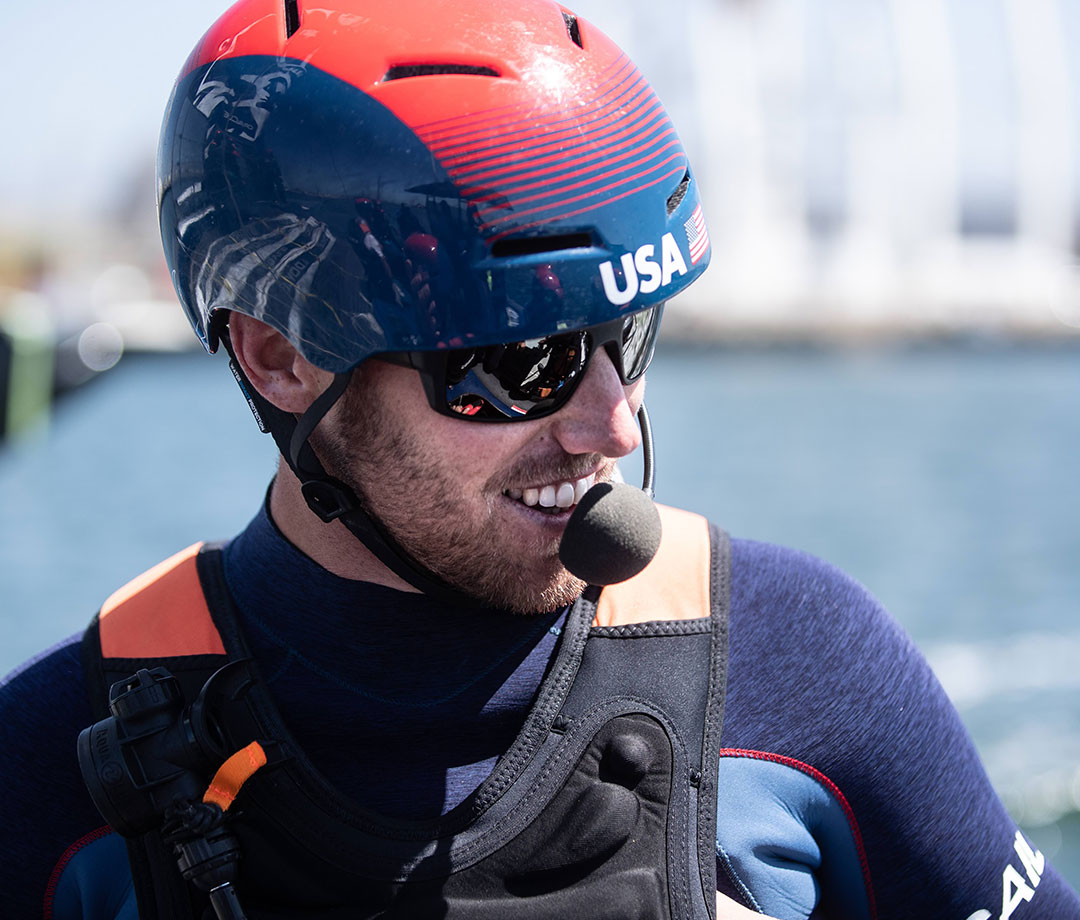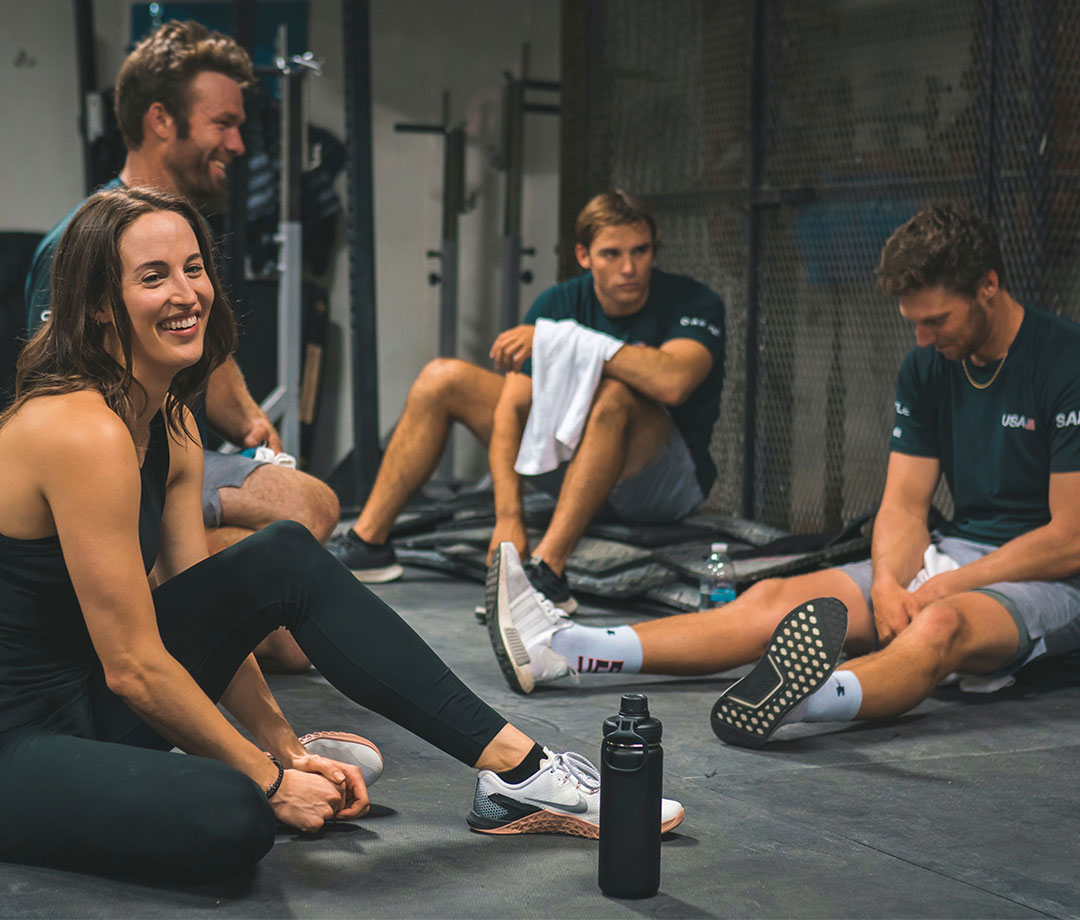While sleeker boat designs and GPS navigation have made everyday sailing lax, relatively humdrum (but enjoyable) endeavors, there’s nothing pedestrian about today’s premier sailing races.
You’ve got the Golden Globe Race, a solo nonstop round-the-world event that’s considered the most dangerous sailing endeavor. The better-known America’s Cup, a prestigious match race that dates back to 1851, in which challenger teams duke it out in the World Series, then go head to head round-robin style in the Louis Vuitton America’s Cup Qualifiers, before advancing to the Playoffs, Semi-Final, and Final against the Defender, competing in foiling AC45S catamarans that’ve been tweaked by each individual team. And the newest race to the yachting circuit, which was just established in 2018: SailGP.

What is SailGP?
“SailGP is a new sailing league that’s worldwide,” says Rome Kirby, helmsman of the U.S. SailGP Team. “It’s nation verse nation. We have five stops this first season.”
Already, regattas have taken place in Sydney, Australia; and San Francisco, CA. New York City is the third, followed by Cowes, UK; and Marseille, France. The event was founded by software billionaire Larry Ellison (Oracle Corporation) and five-time America’s Cup winner Russell Coutts.
While foiling catamarans were used in the America’s Cup, the teams are now competing in 50-foot F50s, which are predicted to surpass 50 knots (60mph). That’s roughly a 15 percent performance upgrade from the AC50 class. (Read all about the new fleet upgrades here.)
“We’re racing the fastest boats in the world,” Kirby says. “You make one wrong mistake, one communication error—you can kill someone, simple as that. The biggest part about having a successful team is having camaraderie and having that trust.”
Kirby, 30, of Newport, Rhode Island, is leading the charge of the young, five-member U.S. SailGP Team, which comprises wing trimmer Riley Gibbs, 22, of Long Beach, California; flight controller Hans Henken, 26, of Coronado, California; grinder Mac Agnese, 24, of Fort Lauderdale, Florida; and grinder Dan Morris, 30, of Newport, Rhode Island.
“People can expect some pretty close racing,” Kirby says. “You’l be able to almost touch the boat. We’ll be coming into the shoreline, and people will be able to see it up close and personal.”

How to Watch
In person:
The teams will race in the Hudson River in downtown Manhattan. There are a few different spectating options. Hop aboard Official Spectator Boats (New York Cruise Lines and Classic Harbor Line) or level up and opt for more premium packages including SailGP Cruise Select (Circle Line Sightseeing Cruises), SailGP Cruise Plus (World Yacht), or SailGP Cruise Premier (Classic Harbor Line) to get as close to the action as possible. You can also watch from the shoreline at the Official Race Village, stationed at Brookfield Place in Battery Park City, which is free to the public. Nab tickets now:
Buy Tickets
On TV:
CBS (delayed broadcast; live broadcast details to be announced shortly)
Friday, 21 June — 8:30-10:00 p.m. ET
Saturday, 22 June — 8:30-10:00 p.m. ET

How to Train Like a Sailor
“We try to train them above what they’ll experience in a race course—a higher heart rate in the training area—which means more physical activity,” says Craig McFarlane, head of performance for U.S. SailGP. “If they come into anything adverse out there, they can handle that. They can handle the extra stress, the higher heart rates, the longer races.”
While nimble, elegant machines, sailing an F50 takes an immense amount of agility, coordination, strength, and endurance—key qualities to any comprehensive training plan.
“We know strength has performance crossover to sports, as well as life,” McFarlane says. “The stronger you are in key movement patterns—such as squatting, hinging, lunging, pushing, pulling, twisting—the easier and more efficiently you’ll move. Planned strength training promotes lean muscle mass and improves resting metabolic rate, which in turn helps you burn more calories and develop better body composition.” In short: Anyone can benefit from training like a sailor.
The U.S. SailGP Workout: Total-Body Strength & Conditioning
Duration: 20min
Warmup
- Cardio x 6-8min: Get your body warm on the treadmill, rower, stationary bike, etc.
- Mobility and Activation x 30 sec each: Leg Swings (stand and use PVC pipe to stay balanced and upright as you swing one leg back and forth; switch); Overhead Squat With PVC Pipe; Good Mornings With PVC Pipe; Shoulder Openers With PVC Pipe (lightly hold PVC and rotate torso side to side); World’s Greatest Stretch
- Agility/Balance/Coordination: Skaters (lateral jump and stick); Single-Leg Catch & Pass With Medicine Ball (perform with partner); 15-meter Band-Resisted Sprints; Mirror Reactive Agility Drills (partner mimics the other as they sprint, pause, and pivot)
Directions: Follow instructions indicated in each phase of the workout. Take 1min to rest and transition between blocks. “Because of the intense nature and physical demands of this workout, I only recommend repeating this three times per week, with a day recovery between or a less intense training day between.
A. Strength
4-min AMRAP to build strength and endurance
- 8 x Barbell Tempo Back Squat (135lb)
- 8 x Barbell Tempo Bentover Row (135lb)
- 8 x Plyo Pushups
- 8 x Jump to Pullup
B. Conditioning
6-min tabata (20 sec of work, 10 sec rest x3) to work mechanical and physiological conditioning
- Row Max Effort (set damper to 10)
- Burpee Jump Over (rower)
- Ski Erg or Assault/AirDyne Bike Max Effort
- Medicine Ball Slams (20-30lb)
C. MetCon
8min block at – race intensity
- 200m Row (set damper to 4)
- 15 x Kettlebell Swings (60lb+)
- 9 x Dead Ball Over Shoulder (70lb+; alternate which should you toss over)
- 0m/5m/10m/15m Pyramid Shuttle (Run to each marker, then back to the start, dropping to a sprawl, then popping back up and repeating.)
The post Young Guns and a Supercharged Catamaran: U.S. SailGP Team Takes on New York City appeared first on Men's Journal.
Comments are closed.